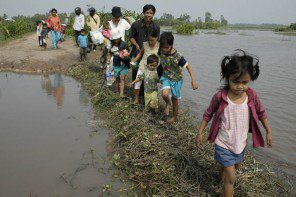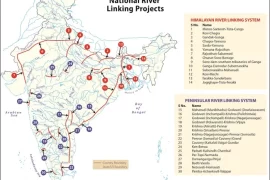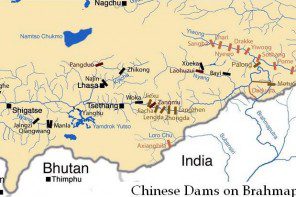The year 2050 is regarded to be a landmark year when the global population will reach to an estimated 9 billion. With no exception to the traditional view, much of the current literatures address this issue exclusively through food production framework. They prioritise the challenges of food production and discount the fact that about one in every eight people in the developing world still remain chronically underfed with an aggregate global food production exceeding present needs of the entire world population (FAO, IFAD and WFP, 2014).It is, however, the question of access to food that sustains the state of hunger for millions of the world’s poor. This sets the platform for the paper as it proceeds to address the issue of ‘land tenure’ to be one of the core food access constraints for poor people. In addition to it, the scope of its focus extends from present circumstances to the emerging climate change conditions in the future.
In the beginning, the paper provides a brief introduction to the concept of ‘access to food’. Then it highlights the food accessibility constraints, particularly on the poor, from broader dynamics of land tenure under existing reality. Finally, the paper attempts to explore some major climate change impacts in relation to land tenure which have the potentials to limit access to food to a further extent.
Understanding ‘Access to Food’
Food security, which is a popular concept in public policies,classically focuses on the volume and supply problems of basic foodstuffs at the international and national levels. Over time, the concept has encompassed a larger extent of issues ranging from food availability, food access and utilisation to overall stability (FAO, 2003). Although access to food stands as one of the key pillars of food security, the issue is actually treated without establishing any effective causation between entitlement challenges and hunger under this discourse. Food systems, on the contrary, not only involve the domain of production but also go deep into the process that associates food access scopes and challenges at large.
Since the emergence of agriculture and the domestication of animals, food systems have constantly evolved with increasing diversity and complexity. Food systems, in general, refer to a certain set of activities related to production, exchange, distribution, consumption and purchase of food that affect the satisfaction of nutritional needs of a particular individual or household in a given time (Cannon, 2002). These activities, which have mutual correlationsare dictated by the political, economic, socio-cultural and natural dynamics where the food systems have evolved.Therefore, through the analytical lens of food systems,access to food refers to the capacity to acquire food by an individual or household either by means of its production or its purchase, what Amartya Sen termed as ‘entitlements’ (Sen, 1981). In other words, food access is determined by the income-based and asset-based food entitlements and in many cases by their combination (Cannon, 2002).
Land Tenure and the Constraints on Access to Food
Access to food depends on the food system dynamics which involve a wide range of combinations from producing all to purchasing all foodstuffs. Therefore, the issues that constrain poor people’s opportunities in food production, sale/exchange, purchase, storage, distribution and consumption ultimately constrain their access to food. This section highlights the land tenure as one of the most significant constraints to food access for the poor under present circumstances.
Historically, land has been the primary source of wealth, power and social status (FAO, 2002). It is one of the most vital assets that offer shelter and commercial potentials, and enable a person or household to engage in agricultural production, particularly in the rural areas. In urban areas, land is becoming increasingly scarce. Access to basic utility services like water, sanitation or electricity, and accessing production related input services such as irrigation, credits or fertiliser are often conditioned by land tenure (FAO, 2002). In fact, from the broader agricultural and economiccontext, the importance of land andassociated natural resource tenure has longbeen accepted. Economic analyses suggestthat rural poverty has a strong correlationwith land tenure (Cotula et al., 2006). Apositive link between fairly distributed landand economic growth has also been revealedin other empirical evidences (Deininger &Squire 1998). According to the study by Abdulai et al. (2011), there are at least threearguments that support the positive effects ofsecured land tenure on investment andproductivity. Again, land tenure is also anaccepted feature that defines the powerstructure of many societies over the world.
Among the 1.1 billion poor people in the world, almost a quarter are landless, while an additional 200 million poor do not have adequate land to secure a decent standard of living (IFAD, 2006). Landlessness is a more prevalent feature in South and South-East Asia where the situation tends to degrade with the increasing population. Between 1970 and 2000, landless population increased in India from 35 to 41% (Aggarwal, 2006). In Bangladesh, almost 60% of the households are absolutely landless, while in Indonesia the fraction is as large as 30% and in Nepal about 25% (Asian NGOCoalition, 2009). Southern Africa (South Africa and Zimbabwe), and Central and South America (Brazil, Guatemala and Honduras) are among other regions of the world suffering from high levels of landlessness (Niasse, 2011). The standard of living and food access of these landless poor are exclusively determined by the amount of physical labour they can sell. Those who remain unemployed or underpaid for their labour become hungrier, and in later times it makes difficult for them to work further. And that is how they are trapped into the vicious cycle of poverty (Dasgupta, 1995).
Unlike other developing parts of the world, Sub-Saharan Africa has an abundance of land with 202 million hectares of potential rain-fed cultivable land that constitutes about half of that of the whole world (Deininger et al., 2011). According to the World Bank, Sub-Saharan economies manifested robust economic growth rates of 6.1% (excluding South Africa) in 2013. Yet the region is the home to almost half of the world’s poor people who heavily depend on land and natural resources for their livelihoods. In reality, African poverty has a strong correlation with insecure land tenure. Almost 90% of the rural land in Sub-Saharan Africa is undocumented or informally administered (Byamugisha, 2013). That is why on one hand, these lands are very much exposed to land grabbing and confiscation without suitable compensation, for instance – commercial investors claimed at least 1 million hectares each in Sudan, Liberia, Ethiopia and Mozambique during 2004-09 (Byamugisha, 2013). While on the other hand, farmers tend to spend least financial capital and physical labour to these insecure lands, and are discouraged to improve production, to adopt new technologies and to promise innovation. Moreover, insecure tenure restricts the access to credit and other input-related services (such as: irrigation) making overall productionsdifficult and so do the food access.
The rural subsistence producers and smallholders who constitute a significant portion of the global poor tend to have limited rights over their lands as well. Even the rights they have are often weak and unprotected, particularly for women. Due to the cultural norms, customs and power-relations in the patriarchal societies, only about 20% of the world’s agricultural lands are owned by women (Spieldoch, 2011). In India, for instance, less than 10% of privately held land is registered in the name of women. Up to 80% of the basic foodstuffs in sub-Saharan Africa are produced by women, while their rights to land and properties are very limited and often conditioned to their marital status(FAO, 2002). As a result, a large portion of these female farmers have minimal control over the food production and management decisions, which ultimately affects the everyday choices and prospects of food access.
Climate Change and the Emerging Challenges
Over the period of 1880 to 2012, the global mean temperature data for combined land andocean surface show a warming of 0.85°C and it is extremely likely, as the Fifth Assessment Report (AR5) of the United Nations Intergovernmental Panel on ClimateChange (IPCC) suggests, thatthe observed warming since the 1950s has mainly been caused by anthropogenic effects(IPCC, 2013). Some of the significant human perturbations identified include emissions ofgreenhouse gases – mainly carbon dioxide, methane, nitrous oxide and chlorofluorocarbons,emissions of aerosols and land use changes. All climate model projections indicate additionalwarming of 2.6 to 4.8 °C in the 21st century given the current anthropogenic emission trends(Royal Society and National Academy of Sciences, 2013).
Negative impacts of climate change may be characterised under the following broadcategories (Padgham, 2009):
- Frequent and intense natural shocks (mainly cyclones, storms, floods, landslides, droughts, heatwaves, wildfires, and cold waves);
- Changes in climate trends and variability, and increased uncertainty (mainly in temperature and precipitation regimes, e.g., changes in seasonality, more frequent temperature and precipitation extremes, floods or droughts becomingmore common and/or affecting new areas); and
- Slow and long-term processes (e.g., sea level rise and salinity intrusion, glaciermelt and changes in water regimes, possible changes in ENSO events etc.).
Although it is difficult to predict when and where the natural shocks might affect, the increasein intensity and frequency of the extreme weather events, such as floods, droughts andhurricanes, are now scientifically agreed. However, the IPCC identifies a range of location specific projected impacts of varyingmagnitude showing developing countries at the brink of vulnerability (IPCC, 2007). Given itsclose interrelations with the climate, it is well accepted today that the impacts of climatechange have the potential to significantly affect the agricultural resource base and toundermine future food system as a whole. The following discussion signifies some keyinterrelated aspects of food access constraints for the poor in relation to land tenure under climate change conditionsandshows how the existing challenges of hunger might be compounded due to climatic impacts.
In its Fourth Assessment Report (AR4) the IPCC concluded that more than 2⁰ of temperature rise would reduce yields in almost all parts of the world (IPCC, 2007). Without considering any adaptation potentials, some studies represent a projected 9-11% decrease in yields of rice, wheat and maize largely in the developing countries, while 25-150% price rise and consequent increase is hunger conditions up to 60% (WFP, 2009). Therefore, climatic change will have significant ripple effects on the stocks and prices of the food stuffsmaking food access more difficult and forcing people to bring more lands under cultivation.
Arable land loss due to climate change impacts is another significant dimension that will potentially affect poor agrarian societies. Studies suggest that tropical and sub-tropical regions such as South America, Africa and India will suffer as much as 21%, 18% and 4% of land loss respectively due to climate change (Zhang & Cai, 2011), while 33% of coastal and wetland will be lost in the 21st century if the present rate of sea-level rise continues (Climate Institute, 2014). Moreover, changes in soil moisture, erosion and land degradation caused by frequent floods, droughts and changes in temperature and precipitation regimes, or salinity intrusion due to sea-level rise will affect the efficiency of land. In effect, not only the crop yield will be hampered but also the production cost will be increased.Additionally, the possibility of further land degradation will rise due to excessive pressure on the rest of the lands.Altogether land tenure will play a significant role in people’s future endeavour to access to food.
Conclusion
The issue of landlessness and insecure land tenure are already conditioning the food systems and access to food, and will continue to push the poor populations to a further marginal position in the coming days. Given the future projection scenarios as represented by the IPCC AR5, climate change will be one of the most crucial determinants of future agricultural production, whereas other potential impacts will be on resource accessibility, infrastructure and people’s overall livelihoods. The global poor living both in rural and urban locations will particularly be the worst victims because of their limited adaptation capacities under a restrained socio-political, economic and cultural conditions prompted by the existing settings. Thus, unless we properly frame the present underlying constraints to food access for the poor, in this case the issue of land tenure, we will not be able to address the emerging climate-induced challenges in the future.
Relevant: CLIMATE CHANGE AND MIGRATION NEXUS: THE WAY FORWARD
Source:
The concept of land tenure is a social construction that generally refers to the set of terms and conditions determining how land and natural resources on the land is used, possessed, purchased, sold, exchanged or managed within societies (Garvelink, 2012).
- Abdulai, A., Owusu, V. and Goetz, R. (2011) ‘Land tenure differences and investment in landimprovement measures: Theoretical and empirical analyses’, Journal of Development Economics,96(1): 66-78.
- Aggarwal, R. M. (2006) Resource-Poor Farmers in South India. On the Margins or Frontiers of Globalization? [Online] UNU-WIDER. Available at: http://www.eldis.org/vfile/upload/1/document/0708/DOC23316.pdf [Accessed: 07.12.2015].
- Asian NGO Coalition (2009) Securing the Right to Land: A CSO Overview on Access to Land in Asia. Philippines: ANGOC.
- Byamugisha, F. F. K. (2013) Securing Africa’s Land for Shared Prosperity. Washington D.C.: World Bank.
- Cannon, T. (2002) ‘Food Security, Food Systems and Livelihoods: Competing Explanations of Hunger’. Die Erde,133(4).
- Climate Institute (2014) Ocean and Sea-level Rise. [Online] Climate Institute. Available at: http://www.climate.org/topics/sea-level/index.html [Accessed 12/12/15].
- Cotula, L., Toulmin, C. and Quan, J. (2006) Better land access for the rural poor: Lessons from experience and challenges ahead, IIED and FAO.
- Dasgupta, P. (1995) Nutritional Status, the Capacity to Work and Poverty Traps. Mimeograph. Cambridge: University of Cambridge.
- Deininger, K. et al. (2011) Rising Global Interest in Farmland: Can It Yield Sustainable and Equitable Benefits? Washington DC: World Bank.
- Deininger, K. and Squire, L. (1998) ‘New ways of looking at old issues: inequality and growth’, Journal of Development Economics, 57(2): 259-87.
- FAO, IFAD and WFP (2014) The State of Food Insecurity in the World 2014. Strengthening the enablingenvironment for food security and nutrition. Rome: FAO.
- FAO (2003) Trade Reforms and Food Security: Conceptualizing the Linkages. Rome: FAO Inter-Departmental Working Group.
- FAO (2002) Gender and Access to Land. FAO Land Tenure Studies No. 4. Rome: Economic and Social Development Department.
- Garvelink, W.J. (2012) ‘Land Tenure, Property Rights, and Rural Economic Development in Africa’,Center for Strategic and International Studies (CSIS), Available at: [Accessed: 05.12.2015].
- IFAD (2006) Empowering the rural poor through access to land. [Online] IFAD. Available at: http://www.ifad.org/events/icarrd/factsheet_eng.pdf [Accessed:12.12.2015].
- IPCC (2013) Summary for Policymakers. In: Solomon, S. et al. (eds.) Climate Change 2013: The Physical Science Basis. Contribution of Working Group I to the Fifth Assessment Report of the Intergovernmental Panel on Climate Change. Cambridge: Cambridge University Press.
- IPCC (2007) Summary for Policymakers. In: Pachauri, R. K. et al. (eds.) Climate Change 2007: Synthesis Report. Contribution of Working Groups I, II and III to the Fourth Assessment Report of the Intergovernmental Panel on Climate Change. Geneva: IPCC.
- Niasse, M. (2011) Access to land and water for the rural poor in a context of growing resource scarcity. Rome:IFAD.
- Padgham, J. (2009) Agricultural Development under a Changing Climate: Opportunities and Challenges forAdaptation.Washington D.C.: World Bank.
- Royal Society and National Academy of Sciences (2013) Climate Change: Evidence and causes. [Online]Royal Society and national Academy of Sciences. Available at: http://dels.nas.edu/resources/staticassets/exec-office-other/climate-change-full.pdf [Accessed: 12/12/15].
- Sen, A. (1981) Poverty and Famines: An Essay on Entitlement and Deprivation. Oxford: Clarendon Press.
- Spieldoch, A. (2011) Women Farmers: Change and Development Agents. [Online] Family Farming World Conference. Available at: http://www.scribd.com/doc/73353429/Refer ence-Document-WOMENFARMERS-AGENT-OF-CHANGE-AND-DEVELOPMENT#scribd [Accessed: 07/12/15].
- WFP (2009) Climate Change and Hunger: Responding to the Challenge. Rome: WFP.
- Zhang, X. and Cai, X. (2011) ‘Climate change impacts on global agricultural land availability’. Environmental Research Letters, 6 (1).
The writer is a Assistant Professor in the Department of International Relations, University of Dhaka.





